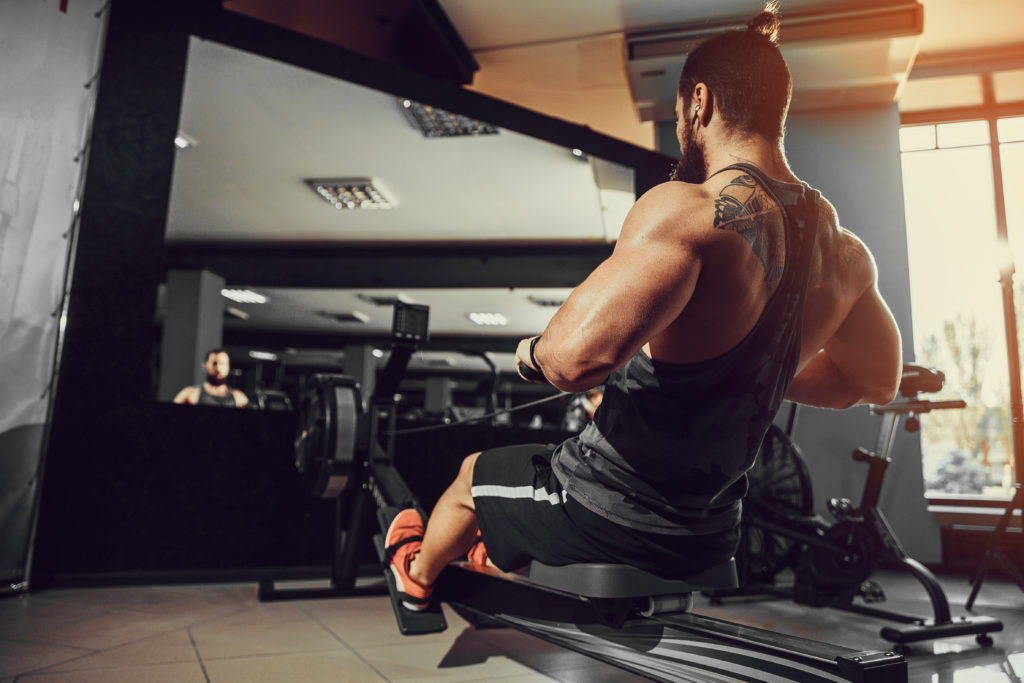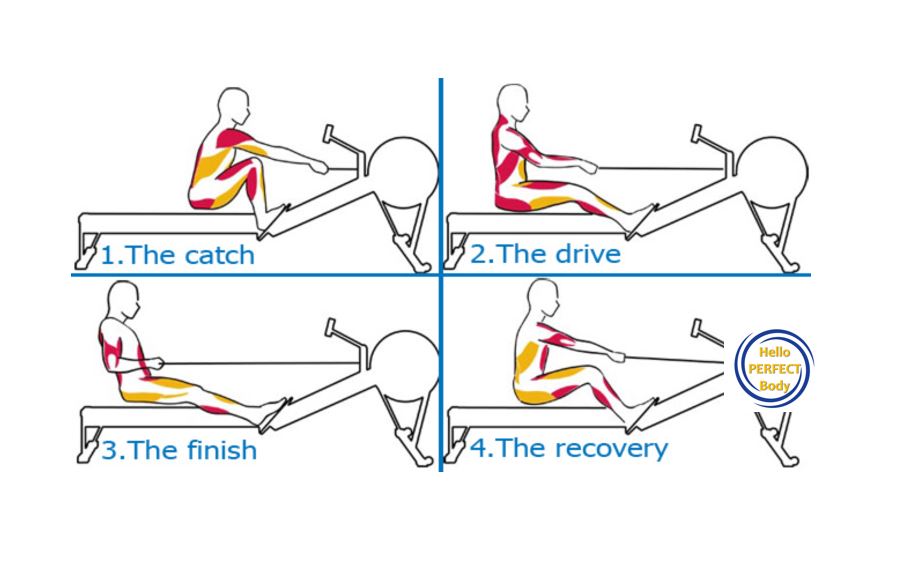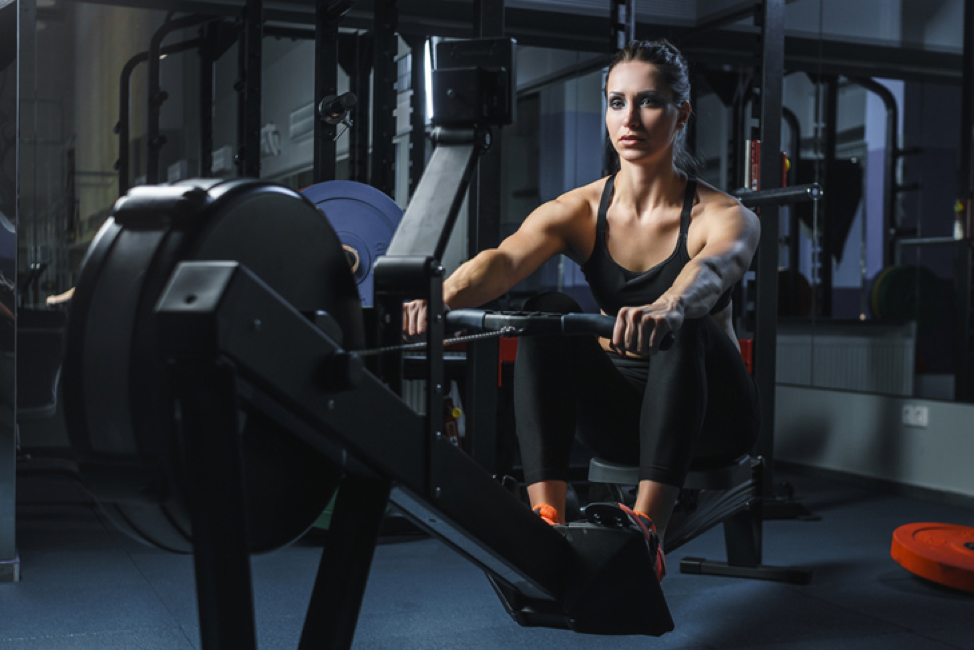
Are you familiar with the rowing machine? You probably heard about it or seen it in your local gym but not have the confidence to try it out. Are you wondering how you can use it to your benefit? You have come to the right place!
A rowing machine workout will build muscle effectively if you do it correctly. Find out how in the sections that follow. We will also cover other vital information to help you achieve your goals!
Proper Rowing Form
So, you have now discovered the rowing machine and feel as if the movement is simple enough, do you think you’re ready to start your rowing machine workout? Not quite.
Before starting on your routine, you must first know how to use a rower properly and safely to improve your gains and prevent injuries.
First of all, you might have rounded shoulders, inactive glutes, and tight hamstrings due to sitting all day and hunching over your desk be it in school or at work. Well, you should first take steps to correct muscular imbalances and weaknesses as well as your posture before getting ready to row.
Have you seen how easy and effortless Olympic rowers make rowing look? Well, make no mistake because the right rowing stroke is very complex, often requiring years to master on the water.
Fortunately, the rowing machine is a much simpler avenue. The form and technique can be perfected with the use of basic knowledge and some practice.
The Rowing Stroke
When doing a rowing machine workout, each stroke can be divided into two main parts namely the drive and the recovery. The drive is when you are working on the stroke while recovery is the bit where you get something like a short break or rest as you get ready for the next drive.
To perform the drive part, follow these steps:
1. Push your feet down and stretch your legs straight to begin the drive. All the while, make sure your arms are also straight, and your hands have a solid grip on the handles.
2. As your legs almost fully straighten, pull your elbows back while bending your arms and pulling the handle forcefully towards your chest.
3. As the drive ends, your torso should lean slightly, and your elbows should be behind your body.
The recovery portion happens when you go back to the starting position by sliding the seat back to your heels and bending the knees. Here are the steps:
1. Allow your hands to move away from your body first.
2. From your hips, pivot the torso towards a strong body position forward with your shoulders placed in front of the hips.
3. Bend your knees and slide down to go back to the starting position. Make sure the handle does not go up and over the knees as you roll up.
4. See to it that the handle is maintained along one horizontal plane for the whole duration of the stroke, which means it should not bob up and down.
Muscles Worked During A Rowing Machine Workout
In other sources, the rowing stroke is further divided into several stages: the catch, the drive, and the finish. To better understand the overall movement, let’s look at each of them and the muscles involved in each stage:
The Catch
The catch is the starting position for the stroke. Here, you are bearing the weight of the stroke, and your body is fully compressed forward, towards your heels. In an actual rowing boat, this is where the blade of your oars are entering the water to “catch” the weight of resistance.
The catch works the muscles of the hamstrings, the soleus, and gastrocnemius of the legs, and theerector spinae of the lower back.
The Drive
The drive is composed of the basic sequence of the rowing stroke: legs first, followed by the back, then lastly, the arms. Some of the common mistakes you should avoid are driving your legs down only after opening up with your shoulders or pulling your arms first before straightening the legs and arching the back.
Similar to a power clean, it is essential to maintain a strong body angle as you push the legs down. You then accelerate through your body and then your arms.
The start of the drive works the quads, rhomboids of the upper back, erector spinae on the lower back, hamstrings, gastrocnemius, and soleus.
The main portion of the drive works on the previously mentioned muscles with an addition of the abs, triceps, trapezius, deltoids, pecs, wrist flexors and extensors, and glutes.
The Finish
This part literally means the finish or ending part of the stroke. It is the body’s position after a stroke is completed, with the shoulders behind the hips, your legs straight, and the handles are drawn close to the lower ribs.
The finish targets the wrist flexors and extensors, deltoids, biceps, triceps, pecs, abs, external and internal obliques, hamstrings, and quads.
The Best Rowing Machine Workout for Building Muscle
Are you ready to get right into the best rowing machine workout? I am!
First things first, make sure you are adequately warmed up for all these exercises. It is recommended to start slow by adding a couple of these exercises to your regular routine for 30 to 40 minutes per week. This should be an excellent way to start your strength training, and you can progress from there.
Also, you can use the rest periods to row at a slow pace with low resistance or stand up to stretch your legs or get your water break.
Power 20’s
- Perform 20 strokes as forcefully and explosively as you can while observing the proper technique and form. Hold the lowest split possible for each stroke.
- Do 10 very light strokes to complete one rep. Use these light strokes to correct your posture and regain your length.
- The rate for these strokes must be between 20 to 24 strokes per minute.
- Complete two sets with 8 reps for each set and taking short breaks no longer than six minutes between sets.
1 Minute On, 1 Minute Off Rowing
- For one minute, row continuously with as much force, speed, and power as you can. Try to hold the lowest split possible.
- For the next minute, take a rest by doing very light strokes.
These two minutes make up one repetition.
- Perform 5 repetitions and then take a short break.
These 5 repetitions equal 1 set
- Complete 3 sets.
The stroke rate for the first set is 18, 20, 22, 24, and 26 strokes per minute (each corresponding to a repetition). For the next two sets, increase the stroke rate by 2 strokes per minute for each consecutive set.
1,000 Meters
- Row for 1,000 meters, being careful to maintain the full length of your legs and focusing on your posture and technique. Hold the lowest split possible. Your goal is to gain a sprint speed that cannot be sustained over long distances.
Each 1000 meter corresponds to 1 set.
- Perform 4 sets, taking 7 minutes of rest between each set.
You can also combine rowing exercises with other exercises for maximum gains. Here are two examples of workout routines you can try:
Rowing Machine Workout #1.
- Five-minute warm-up
- Row at a moderate pace for up to 100 meters
- 10 repetitions of bodyweight squats
- Perform another 200 meters of rowing
- 10 reps of bodyweight squats then 20 alternate reverse lunges
- 10 bicep curls to overhead press before ending the exercise
- Repeat this entire workout three times, resting when you need to.
Rowing Machine Workout #2
- Warm-up for five minutes
- Row as fast and explosively until a 100-meter point is reached
- 5 bodyweight squats, 5 pushups, and 5 feet-elevated mountain climbers
Rest
- Row as fast and explosively until a 200-meter point is reached
- 10 bodyweight squats, 10 pushups, and 10 feet-elevated mountain climbers
Rest
- Row as fast and explosively until a 100-meter point is reached
- 15 bodyweight squats, 15 pushups, and 15 feet-elevated mountain climbers
When you feel satisfied with your workout, finish it with a one-minute plank.
Benefits of a Rowing Machine Workout
Aside from helping build your muscles, a rowing machine also has other impressive benefits. Here are some of them:
1. Cardiovascular Exercise and Aerobic Conditioning
An excellent aerobic or cardiovascular exercise is anything that raises your heart rate and keeps it at a certain level for a certain amount of time. This type of activities stimulates and strengthen the lungs and heart, which in turn improves the body’s ability to utilize oxygen.
Using a rowing machine is a tremendous overall aerobic workout. It also gets your heart pumping and your blood flowing.
According to the American College of Sports Medicine (ACSM), even healthy adults need at least 150 minutes of moderate exercise like rowing each week. This can also be done through 20 to 60 minutes of vigorous exercise thrice a week or 30 to 60 minutes of moderate exercise for five days a week.
What’s great about a rowing machine is that you can use it to exercise both in a vigorous and moderate intensity range. Some versions also come with built-in heart rate monitors to ensure to are reaching your goals without going overboard with your exercise.
2. Shed Fat and Lose Weight
The rowing machine also targets almost all vital muscle groups, keeping your whole body working. This makes it extremely effective in helping you lose weight by burning calories the entire time you are using it. In fact, rowing is the top aerobic exercise for burning calories, followed closely by ballet.
Since you also row at a pace that allows you to perform an exercise nonstop for a few minutes, it also works the muscles to tone them and shed excess fat.
3. Versatility
Did you know that you can also use a rowing machine to perform high-intensity interval training (HIIT) exercises? Yes! You can incorporate not only aerobic but also anaerobic exercises to your routine.
Switching between anaerobic and aerobic exercises is made even easier thanks to the resistance adjustability of most modern rowing machines.
Simply lower the resistance and work at a slower pace if you want an aerobic workout but want to develop sufficient stamina to finish your exercise. This allows you to preserve your energy and stretch it out over a more extended period.
On the other hand, you can amp up the resistance and pick up some speed in rowing for an excellent anaerobic workout!
4. Total-body Conditioning
Rowing is considered a total-body workout because it conditions both the upper and lower body including the shoulder muscles, glutes, abs, triceps, biceps, deltoids, lats, obliques, hamstrings, calves, quadriceps, and the lower and upper back.
It also helps strengthen your grip by targeting your wrists and hands as you hold onto the rower handles.
5. Low-Impact and Non-Weight Bearing
The motion performed when using a rowing machine mimics the natural movement of the body and tends to be low impact. Because a person sits comfortably at an angle and close to the ground, minimal stress is felt by the joints or any other body part.
Compared to other aerobic exercises like running, jumping, and jogging, this makes it more suitable for the elderly as well as people with mobility problems. Since rowing is performed while in a seated position, your lower body is not bearing the weight of your body, it is also great for patients who have weak joints or are undergoing rehabilitation after surgery.
Even if you do not have bad joints right now, you might have problems sooner or later. So, make it a point to incorporate low impact exercises like rowing into your workout routines!
Conclusion:
Still wondering if rowing machine workouts will build muscle? Definitely! By knowing how they work, the different muscles targeted, the amazing benefits, and how to perform these exercises, you are now well on your way to that toned, sculpted body of your dreams!
If you are looking for the best rowing machine, check out thisConcept 2 Rower Reviewand find out how it can help you achieve your fitness goals!
Terry Asher
Latest posts by Terry Asher (see all)
- Better Family – Product Review Liquid Daily 2 oz - Dec 16, 2024
- Post-Workout Recovery: The Key to Optimal Performance - Nov 25, 2024
- Pre-Workout Supplements – Everything You Need To Know - Nov 18, 2024












[…] Read more Here | 2019-05-09 20:59:13 Image credit: source Facebook Twitter Google+ Pinterest […]
[…] post Rowing Machine Workout For Building Muscle appeared first on Gym […]
[…] Read The Entire Article By Terry Asher Here. […]
Great roundup, thanks for sharing. I also switched to a healthier lifestyle, gave up smoking and started a SportMe app marathon training. My quest to a healthy life had a lot of ups and downs, but things are on the right track now. Your blog posts are truly inspirational, txs!
[…] 2019-05-10 02:29:13 https://gymjunkies.com/wp-content/uploads/2019/05/shutterstock_721946053.jpg Source link […]
Great tips! This low impact workout is best for me because i have a sensitive knee. I hope this exercise helps me to strengthen my knees. Thank you for sharing 🙂
Thank you for sharing such a great tips, i hope this workout helping me to build Muscle.
how exercise affects the body
Very nice information you share with us. Thanks for this.